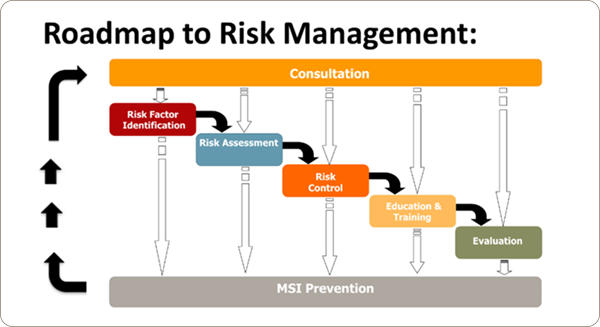| |
|
Risk factor identification and assessment 
Risk factor identification The objective of risk factor identification is to determine workplace factors that may affect the risk of an MSI. It’s the first step in the process of eliminating or minimizing the risk of an MSI in the workplace. Educating workers on the signs and symptoms, health effects, and risk factors of MSIs can help manage the risk. UBC recognized the risk factors in the challenges workers were having with moving appliances. They engaged their teams to understand the constraints of the built environment and how it contributed to the risk of an MSI. For example, the older buildings where the work was being done did not have elevators and had many narrow staircases, making it difficult to manually move heavy appliances. Risk factor assessment The next step in the MSI risk management process is risk factor assessment. The objective of risk assessment is to determine the degree of risk to workers by considering the magnitude, duration, and frequency of exposure to the workplace factors identified in the previous step. To determine the degree of risk, UBC looked at the significant physical demands involved with moving specific appliances in constrained environments. They started with evaluating the primary risk factors: the force required, the awkward work postures, and the contact stresses. They then considered the manual pushing, pulling, lifting, and carrying workers had to do to perform the task. They also determined the impact of contributing risk factors: aspects of the layout and condition of the workplace, the floor surface (i.e., slope and stairs), and the characteristics of the appliances, including their weight, size, and shape. In addition, they considered when workers were moving the appliances, to where, and how often. In consultation with their on-staff UBC ergonomists, the team observed the work activities, referenced validated ergonomic risk assessment tools, and consulted with front-line staff on the challenges of the tasks. This holistic approach confirmed the concerns and demonstrated the benefits of looking at effective and sustainable solutions. Visit worksafebc.com to learn more about managing risk and controlling risks. Read more We're here to help For resources, please visit worksafebc.com/ergonomics. If you have questions about ergonomics or human factors, or need help managing the risk of MSI in your workplace, please contact us at HumanFactors@worksafebc.com | |
 |
WorkSafeBC, PO Box 5350 Stn Terminal, Vancouver BC V6B 5L5
